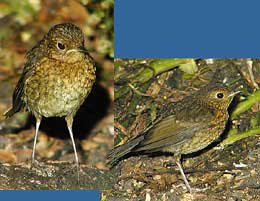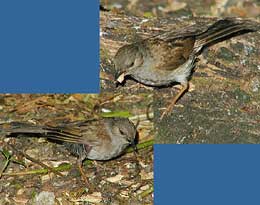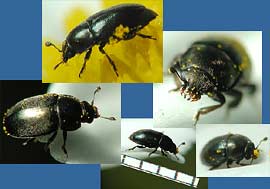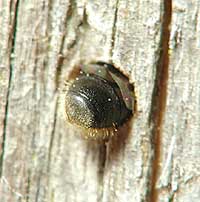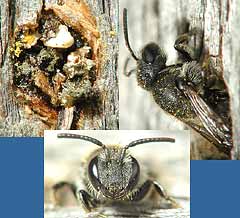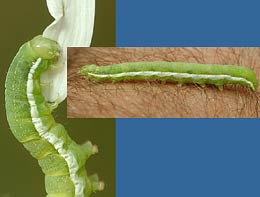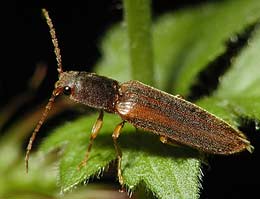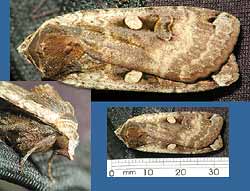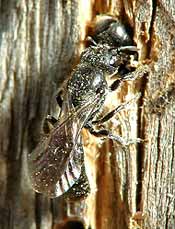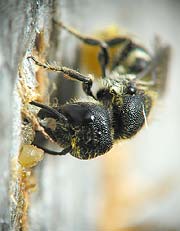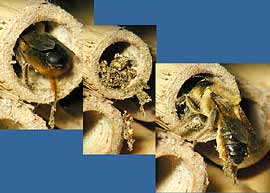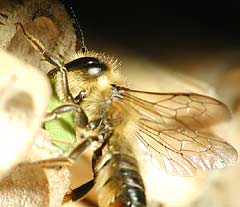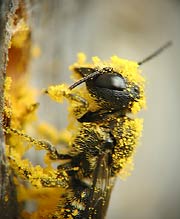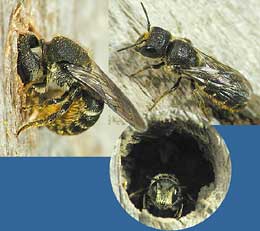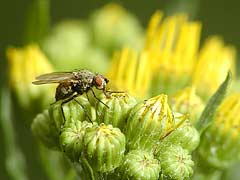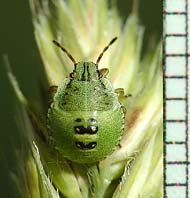Go to latest entry.....................................Go to previous entry22 June - I was sitting on the verandah in my shorts, drinking tea just after 7am this morning, as the thunder rolled in the distance and the occasional lightning flash startled the birds. By 9am the temperature had dropped enough for me to change back into jeans. In the rain, the frogs were hopping about and seemed to appreciate the mealworms thrown to them. While I sat outside I had my first proper sighting of a juvenile Robin this year as it came down to feed under the Hawthorn. One of the adults still takes food away, although I don't know whether that is to feed this youngster or some other(s).
These two images are of the Dunnock with the injured leg that I last photographed on 17 May. In the lower picture you can see the damaged area right at the top of the right leg. Despite this, the bird's gait seems to be almost normal now. It is busy taking food away at the moment and made a lot of visits while I watched. In the upper image it is holding a mealworm pupa in its beak.
The Song Thrush was also taking food away this morning, as was the Chaffinch. I had a good look at the female Chaffinch, and she seems to have lost a clump of feathers on the back of her head (although it doesn't seem to be causing her any problems). I must try to get a photograph of her.
23 June - It has been a dry, warm Monday after a wet night and I have spent much of the day at the top of a ladder (and scaffolding tower) removing the old guttering and its associated timber from the back of our house. The exposed beams etc have now all been treated and every thing is ready for me to put up the new bits tomorrow (the weather forecast promises a dry night!). Just one photographic subject today. This evening I took my usual look at the Ox-eye Daisies and saw twelve of these tiny beetles on the flower heads. Measuring 3mm at the most, they are very sensitive to movement and scurry off to the side of the flower. I noticed several of them seemed to carry of a 'mouthful' of pollen as they went (top-left and bottom-right images).
Curiously, there is another solitary bee 'camping out' on a daisy tonight, for the first time since I photographed this happening on 18 June.
25 June - We are having another period of brilliantly sunny weather and I took full advantage of it yesterday to complete the guttering job - today I will need to do a few more bits and pieces before I dismantle the scaffolding tower. While I was at the top of a ladder I was treated to the sight of a Ruby-tailed wasp (probably Chrysis ingnita) searching the wall for solitary bee nests. It was small, but in the bright afternoon sunshine its irridescent green head and thorax contrasted brilliantly with its red abdomen. Sadly, there was no chance to take a photograph. 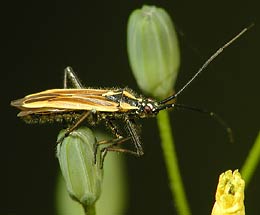
During a break in the work I spotted this caspid bug (Notostira elongata - I think) that was perched on a Nipplewort flower bud. To give an idea of scale, the bud measures about 6mm in height.
A solitary bee stayed on an Ox-eye Daisy flower again last night, and was still there this morning at 8.15am as the sun came over the rooftops.
26 June - Another nice day, much of which was spent going up and down a ladder!
Also, I saw this rear end protruding from a wood-worm hole which has a diameter of about 1.5mm. It belongs to a tiny bee. I hope to get some photographs of the rest of the bee tomorrow. After seeing this bee I spent some time drilling some 1.5mm and 2mm holes in the timber of the bee hotel.
The bee in the images spent a long time in the pose shown, although it occasionally rotated to point in different directions. When it flew off, I could see that the hole was sealed, about 4-5mm from the surface. That seal is smooth. A check of the unsealed 3.5mm holes tonight revealed that every one of them has a bee in rsidence fopr the night.
I think that it is a Hebrew Character moth (Orthosia gothica). Caterpillars of this species feed on plants of the dandelion family, and when I tried to egt it to go onto aan Ox-eye Daisy it started eating a petal before it had even let go of my finger.
During the day several butterflies passed through the garden. I saw a couple of Small Whites, and Sheila saw a small brown coloured one. The Song Thrush continues to take raisins away and has become used to my movements nearby. I don't see any of the other birds taking food away at the moment. There was actually a Blue Tit down feeding under the Hawthorn, but there is still no sign of any BT youngsters about. In the evening the Song Thrush can be heard singing from the Brickfields Country Park and in the sky the Screams of the Swifts are very loud as they fly over us in groups. House Martins seem few in number and there is no sign of any nesting in our road.
28 June - The weather has remained dry with only a few spots of rain since I completed the guttering - we are promised heavy rain for the beginning of next week ( it will be the second week of Wimbledon, after all!).
The one picture I did take was of this click beetle (Athous haemorrhoidalis), measuring about 14mm long.
Although I missed the moths last night, this one was found resting on the verandah this morning. I'm having a problem with identification. Its hind wings are quite bright orange with a dark band across them, similar in pattern to those of the Large Yellow Underwing.
A couple of days ago I photographed the rear of a bee in one of the 1.5mm holes. Today I spent a bit of time watching the bees again and had another rear end in my sights. As I watched, the bee's partner(?) turned up and spent ages apparently nibbling at and (or) around the visible abdomen before flying away. It returned after a while and the process was repeated. The female(?) was obviously busy doing something in the hole as every-so-oten she would reverse partly out of the hole and twist to face a different direction as she went back in. Eventually she reversed out completely, turned around and re-entered the hole tail first.
While the sun shines on the bee hotel activity gets quite frantic, and this picture shows one of the bees that is using the 3.5mm holes as it puts the final touches to seal on the entrance of one of them.
This afternoon our attention shifted to the bamboo tubes used for the first time by the leaf cutter bees last year. I spotted the year's first leaf cutter bee busy cleaning out one of the tubes. In fact, you could hear the sound of dry leaves being broken up from a couple of feet away. Last year I didn't see the first leaf-cutter bees until the 19th July.
We had to go out for an hour, and when we returned the Spring-clean of the bamnboo had finished and the bee had already started to build the first partitions at the back of the tube. A quick check of a nearby rose revealed the probable source of the first leaf pieces being used today.
29 June- Just a brief entry today as the very warm and dry weather continues. The Song Thrush, Blackbird(s) and a couple of House Sparrows continue to take food away from the garden. This morning there were two juvenile Robins together under the Hawthorn tree. I did not use my camera much today but I did spend a bit of time watching the bee hotel and was rewarded with this sight. I was concentrating on a 3.5mm hole that stood out from the rest because of the amount of pollen that was stuck to the wood around the entrance. The reason for this mess became apparent as this bee turned up, covered from head to tail in pollen. I managed to grab the (slightly shaky) picture as it wiped an antenna before disappearing into the hole. Usually the pollen is concentrated under the abdomen, so I don't know why this bee had to be different!
30 June - Rain last night, along with some thunder and lightning, but after a bit more rain first thing this morning the rest of the day has been bright and dry.
The upper left image shows a bee nibbling at the sides of a 3.5mm tube entrance. It provided an opportunity to see the 'neck' of the bee. Notice how the front of the thorax has a sort of collar which seems to fit into the cavity at the back of the head in usual vievs of the bee (top right image). Also, you can see the hairs under the abdomen that are used to hold the pollen collected by the bee. The leaf-cutter bee has been active again. The bamboo tube it cleaned out yesterday is now sealed about 1cm from the entrance and the bee has started taking leaves into an adjacent tube. The first Ragwort flower opened today, and there are a lot more buds waiting their turns. I didn't take a picture of the fully open flower, but instead I took a photograph of one of the flies that are constant companions of the Ragwort buds each year. This one is feeding.
The grass by the pond still has its capsid bugs, and also several shield bug nymphs like this one. I could also see a ladybird larva, but there was no sign of the hoverfly larvae that I pictured on 19 June.
I forgot to mention that two days ago I saw a Sparrowhawk attack in the garden for the first time for a good few weeks. |
|
